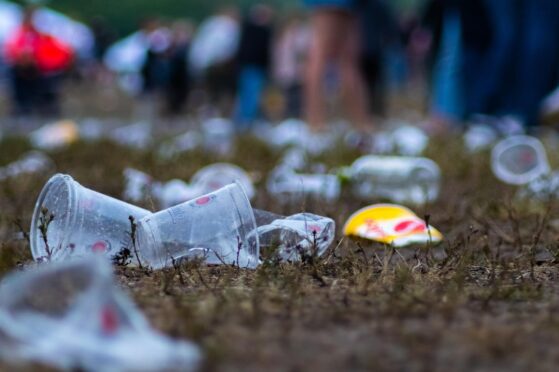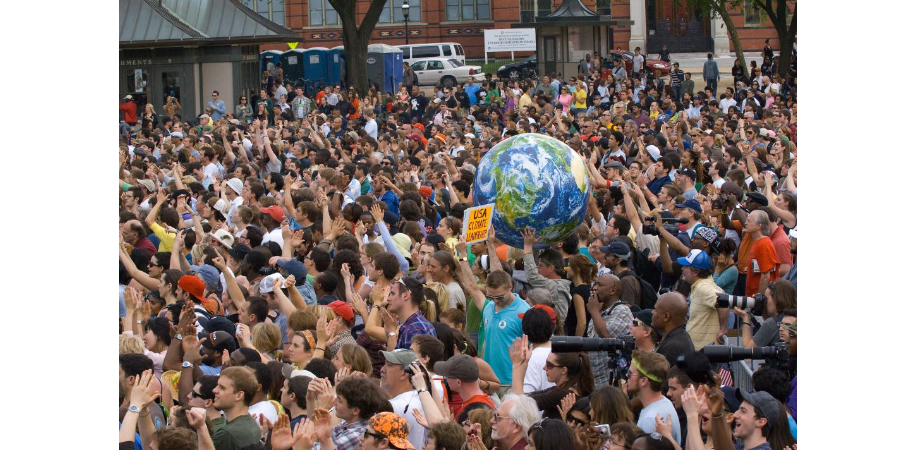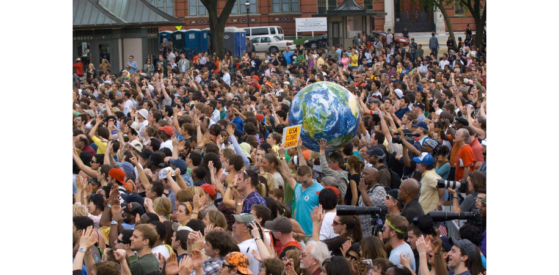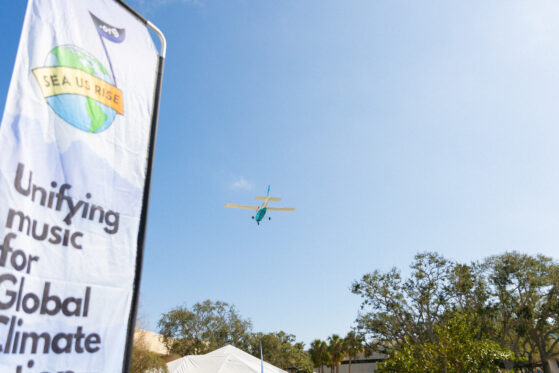Bands and artists have been responding to the threats of climate change for years. Now venues, labels, suppliers, and other facets of the music industry are starting to shift their practices. (If you want to find out specific resources, check out our Green Resources page.)
Why should music festivals be concerned?
Music festivals are a multibillion dollar industry, roaring back as societies shift into post-pandemic mode. Fans want to see their favorite bands, and each other. Vendors want to sell as much as possible. Artists want to connect with their audiences, and everyone wants the full consumer experience.
That means artists, crew, attendees, equipment, swag, and staff all need transportation to and from the festival.
Stages at the festival are one energy component. All of the vendors, offices, ticket areas, lighting, ambient sound, and often silent discos and other assets require huge amounts of energy. Air conditioning, plugged in trailers, lighting and much more use many thousands megawatts of electricity. All that requires lots of generators.
Water, drinks, adult beverages, food, packaging, printed programs and lots more end up in, or near, trash cans, even when there are recycle bins. The amount of waste at a music festival is staggering.
According to the Washington Post,
…an environmental impact report on Coachella and other festivals held on the Indio grounds by event organizer Goldenvoice, these events generate an estimated 1,612 tons of solid waste annually, or about 107 tons per festival day. Only 20 percent of that waste is recycled.
The world’s most sustainable music festival?
A great example of the ways music festivals can be carbon net zero or positive is the DGTL Amsterdam, which one article called ‘The World’s Most Sustainable Music Festival.’ Not only do they operate with a hard cup system for all drinks, eliminating plastic and cup waste, but they eliminated parking.
Attendees are encouraged to come by public transportation, bicycles, and even a special event ferry they set up. The event was solar powered, and used low and zero emission equipment. Artists stayed in sustainable hotels; the food was vegan; and the toilets were dry and even that waste was used. It can be done!
Meadows in the Mountain is another music festival aiming to be net zero. This Bulgaria based festival writes on their website,
Our identity has evolved from a small party to international community with a focus towards platforming the arts, protecting/regenerating our mountain and educating our family on how to change habits from destructive to regenerative.
What can music festivals be doing?
Three of the components that music festivals are addressing (or should be) are transportation, waste, and power. Festivals aren’t alone in working on these areas. Multiple organizations, some powered by musicians, have popped up to help green music festivals.
One organization is Reverb, founded by musician Adam Gardner and environmentalist Lauren Sullivan in 2004. They are currently working with artist like Billie Eilish, Lorde, The Lumineers, and others to lessen the environmental impact of touring.
Transportation
Undoubtedly, getting everyone and everything to and from the festival has, by far, the biggest impact on the environment. Using trains to get to the show isn’t always possible for the artists, workers, and attendees, and unlikely for the vendors. Many of the large festivals now talk about using carbon offsets to ameliorate some of their environmental damage.
2021’s Global Citizen Live used carbon offset programs to help get to net zero environmental harm. By working with the South Pole Company, Global Citizen first calculated how much carbon they would produce. They then first tried to reduce the amount. Then the new predicted balance was calculated, and the organization paid South Pole for each ton of carbon. Then South Pole used that money to invest in indigenous communities’ health, education, and ecosystems.
Transportation will continue to be the most difficult part of the climate puzzle to solve for music festivals. Carbon offsets are not a solution, but a way to help while solutions are developed. Bands can encourage fans to use public transportation to attend. Companies can switch to electric vehicles. But until there is a less harmful way to fly, touring and mega-concerts for musicians will always impact the environment.
Energy
Gotta turn on the lights, turn up the speakers, and turn out the crowd. All of that uses a lot of electricity. Many music festivals haul in dozens of generators to make the festival possible. How can they be powered without fossil fuel?
Artist AY Young created The Battery Tour, a movement to help musicians tour at net zero, among many other goals.
The Battery Tour is a renewable-energy powered concert series that raises money through donations to purchase portable, solar powered boxes for villages that do not have reliable access to electricity. It builds communities and inspires people to positively impact the world and build a better, more sustainable future together.
The Glastonbury Festival uses a combination of solar panels, wind power, and biofuel, though they still have some traditional generators used. Some smaller festivals are able to power themselves through mobile solar generators, such as Arizona’s McDowell Mountain Music Festival (M3F).
While not a music festival, a nightclub in Glasgow, SWG3, uses the body heat from the dance floor to power the entire club. Energy is an area that most music festivals can address.
Waste
It’s a terrible sight, at the end of the night, or end of the fest, to see the sea of plastic cups, bott les, and other trash ruining what probably was a lovely location. Plastic is the most obvious culprit, especially water bottles. The Gasparilla Music Festival eliminated bottles and has boxed water and refill stations.
les, and other trash ruining what probably was a lovely location. Plastic is the most obvious culprit, especially water bottles. The Gasparilla Music Festival eliminated bottles and has boxed water and refill stations.
Food waste is also a problem. Uneaten food goes to the landfill. Organizations like Clean Vibes work with festivals to compost uneaten food (230,000 tons at Bonaroo!).
A couple of music fans and entrepreneurs noticed that there were scores of plastic tents abandoned at music festivals (1 out of 4). Jan Portheine and Woot Kommer started their Nederland company, Kartent, to make reusable and recyclable tents for festivals. They deliver the tents and pick them up after the festival to recycle into more tents. That grew into an entire cardboard furniture company. Solving environmental problems can be profitable.
Musicians, promoters, venues, and the whole industry are finally looking at ways to green up music festivals. Ideally they will accelerate their work. It’s up to the music fans to make sure they do.




